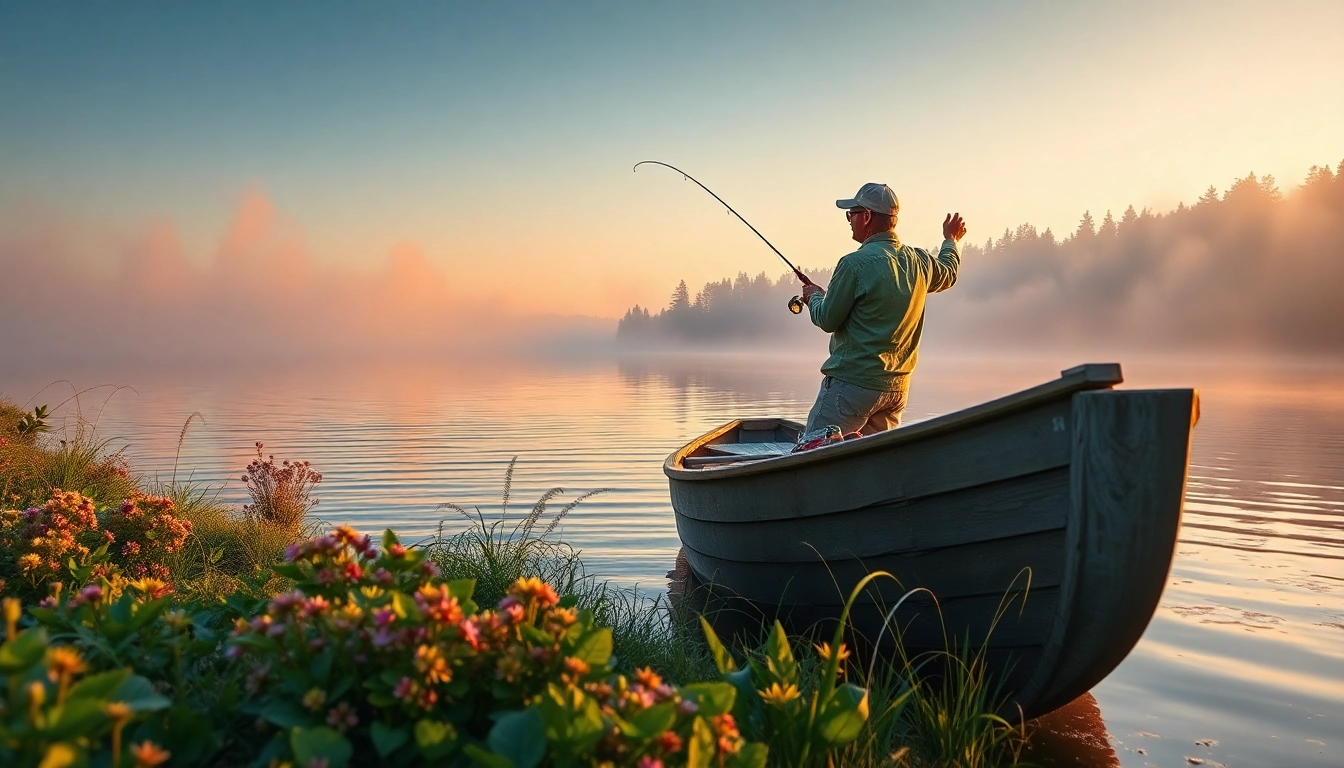
Understanding Fly Fishing for Bass
Fly fishing for bass combines the elegance of fly-casting techniques with the thrill of pursuing one of the most popular freshwater game fish. Whether targeting Fly fishing for bass in lakes, rivers, or ponds, understanding the fundamentals of bass behavior, equipment choices, and effective techniques can significantly improve your chances of landing that prized catch.
The Science Behind Bass Behavior
Bass, particularly largemouth and smallmouth, exhibit fascinating behavior influenced by their environment, seasons, and feeding patterns. Understanding these factors aids anglers in determining the best times and methods for successful catches.
During spring, as temperatures rise, bass move closer to shore for spawning. This period provides excellent fly fishing opportunities, especially in shallow waters where they can be found guarding their nests. Summer sees bass retreating to deeper, cooler waters during the hottest parts of the day. Conversely, in autumn, they prepare for winter by feeding aggressively, making this season ripe for targeting with the right fly patterns.
Moreover, bass are opportunistic feeders, often targeting smaller baitfish, crustaceans, and insects. An angler’s success can be largely attributed to understanding what bass are feeding on at any given time, allowing for strategic fly selection that mimics their natural prey.
Choosing the Right Gear for Fly Fishing for Bass
The right equipment plays a critical role in fly fishing for bass. Utilizing a quality fly rod, reel, and line suited to bass fishing’s unique demands can enhance your efficiency and enjoyment in this sport.
Typically, a rod weight of 6 to 8 is recommended for bass fishing. Lighter rods may struggle with large bass, while heavier rods can provide better leverage. A medium-fast to fast action rod is ideal for casting larger flies and delivering them with precision. When it comes to reels, look for one that offers smooth drag and adequate backing capacity to handle a fighting bass.
Your fly line should be matched to your rod’s weight and type of fishing. Floating lines are advantageous for topwater techniques while sink tip or full sinking lines will allow your flies to reach deeper water. Don’t forget the importance of leaders and tippets—these should be durable enough to withstand bass strikes, with a length that matches the conditions of your fishing environment.
Seasonal Considerations and Techniques
Understanding seasonal behavior allows anglers to tailor their approach for greater success. Each season requires specific strategies related to bass behavior, water temperature, and prey availability.
In spring, focus on shallow waters using poppers or small streamers that imitate spawning baitfish. As water temperatures rise and bass retreat to cooler depths, switch to larger, more weighted flies in the summer. Autumn provides an opportunity to capitalize on the aggressive feeding frenzy of bass, where larger flies can be utilized to imitate larger prey mimicking the natural forage available in this season.
Essential Flies for Bass
The selection of flies can impact your effectiveness in catching bass. Different patterns serve various purposes depending on the season, water conditions, and feeding habits of the fish.
Top Patterns for Largemouth and Smallmouth Bass
When targeting largemouth and smallmouth bass, several fly patterns have proven effective. Poppers, such as the Dahlberg Diver or the Gurglers, are great for surface fishing, especially in warmer months when bass are actively feeding on top. Crayfish and baitfish imitations, like the Clouser Minow or the Lefty’s Deceiver, are effective when submerged. Use these patterns in areas with structure or cover where bass like to hide.
Crafting Your Own Flies
A rewarding aspect of the fly fishing community is the opportunity to craft your own flies. Not only does this enhance your skills, but it also lets you tailor flies to your local waters and the specific conditions you encounter.
Basic materials for crafting bass flies include hooks, threads, feathers, and synthetic materials. Creating a diverse fly box that includes various colors and size combinations can help you adapt to different situational needs while fishing. You can find many resources and tutorials online to guide you in creating effective patterns that resonate well with bass.
Fly Materials and Their Impact on Performance
The materials you choose for your flies can significantly impact performance. Lightweight synthetic materials may enhance aerodynamics while heavier options can be beneficial in the water to create movement and presence, attracting bass.
Additionally, considering the color and visibility of your fly can also affect success—brighter colors are excellent for murky waters, while more natural hues work well in clear conditions. Experimentation with different materials and patterns can lead to discovering what works best for you and your fishing environment.
Fly Fishing Techniques to Catch More Bass
Successful fly fishing for bass involves mastering a variety of techniques. Improving your skills can enhance your overall fishing experience and, most importantly, your catch rate.
Effective Casting Strategies
The art of casting is critical in fly fishing. Accuracy and distance will aid you in reaching areas where bass may be hiding. Practice different casting techniques such as the roll cast, double haul, and sidearm casts to improve your versatility and efficiency. Tailoring your casting style to the conditions you’re fishing can yield better results, especially in tight spots where precision is key.
Retrieval Techniques for Bass
Retrieval is equally important in enticing bass to strike. Varying your retrieve speed—be it slow and steady or fast and erratic—allows you to mimic the movements of prey effectively. Implementing a pause-and-retrieve technique, mimicking the stop-and-go motion of injured baitfish, often provokes a strike from lurking bass.
Understanding Water Depths and Structures
Understanding your fishing environment is essential. Bass often relate to structures such as rocks, weeds, and submerged logs, where they can ambush their prey. Identifying these features on the water’s surface can indicate prime fishing spots. Use depthfinders or challenge yourself to map out areas based on your experiences.
Moreover, varying depths can influence which flies are most effective. Experimenting with different fly sizes and sinking methods can help you find bass wherever they are holding in the water column.
Tackle and Equipment Recommendations
The right tackle can significantly enhance your fly fishing experience. Understanding the components of your gear and how they work together is vital in achieving success on the water.
Selecting the Right Rod and Reel Combo
Choosing the appropriate rod and reel combo depends on your fly fishing style, target species, and specific conditions. Aim for a rod that complements the types of flies you plan to use while also fitting within your physical capabilities. A quality reel should provide a balanced feel and allow for easy adjustments when landing a fish.
Moreover, consider the materials and technology of your gear. Graphite rods offer sensitivity and performance, while reels with sealed drag systems are excellent for durability against the elements. Always assess your gear’s compatibility with one another to ensure optimal performance.
Tips on Leaders and Tippets
Leaders and tippets are critical elements of the fly fishing setup, acting as connections between your fly and the fly line. Proper leader length can vary based on the fishing conditions, with longer leaders often better for clear water situations.
Using fluorocarbon tippets can be advantageous due to their low visibility in the water and increased abrasion resistance. Be mindful of the line’s breaking strength, ensuring it matches the rod, reel, and conditions of your fishing environment to avoid break-offs during a fight.
Maintenance of Fly Fishing Gear
Proper maintenance of your fly fishing gear is crucial for its longevity and performance. Regularly inspect your fly rod for any fractures or wear, and ensure guides are free of debris.
For reels, clean and lubricate moving parts to maintain optimal drag functionality. Wash all lines thoroughly with warm water to remove dirt and salt, which could impair their performance. Regular care will not only prolong the life of your gear but will also enhance your overall fishing experience.
Enhancing Your Fly Fishing Experience
Beyond the technical aspects of fly fishing, there are several ways to enhance your overall experience, from connecting with local communities to integrating technology into your fishing pursuits.
Local Resources and Communities
Connecting with local fishing communities can provide valuable resources, including tips from experienced anglers, guides, and recommendations on the best fishing spots. Participating in local fishing clinics or workshops allows you to gain insights and hone your skills further.
Many regions have fly fishing clubs that foster knowledge-sharing and camaraderie among enthusiasts. Involvement in these communities opens doors to new friendships and greater enjoyment of the sport.
Using Technology to Your Advantage
Modern technology can be an invaluable asset in your fly fishing journey. Apps designed for anglers offer insights into weather patterns, water levels, and fishing conditions, helping you make informed decisions on where and when to fish.
Furthermore, utilizing fish finders or sonar devices can aid in identifying schools of fish, particularly when targeting bass in deeper waters. Documenting your trips through social media or digital journals can also help you analyze patterns and improve your techniques over time.
Planning Your Next Fly Fishing for Bass Trip
Planning your fly fishing adventures requires consideration of multiple factors, including location, season, and conditions. Identify regions known for bass populations and research local regulations to ensure compliance with fishing rules.
Creating a checklist for what gear to pack, including flies, tackle, and personal items, can streamline your trips. Carve out time to study maps and familiarize yourself with the waterways, significantly enhancing your chances for a fruitful fishing experience.
By adopting the insights shared here, you can refine your approach to fly fishing for bass and enjoy the rewarding challenges that make this activity an enduring favorite among anglers of all levels.





